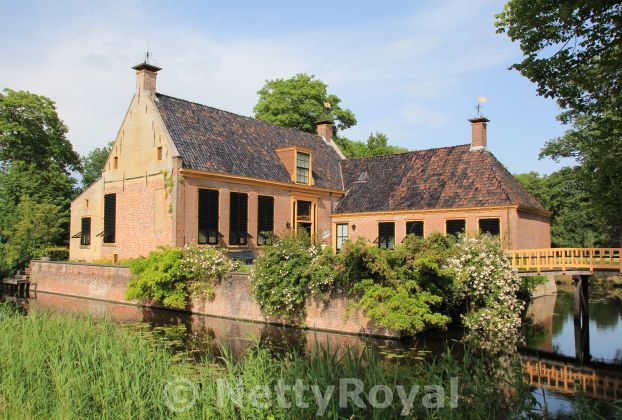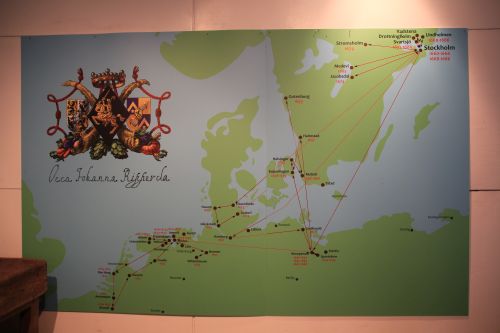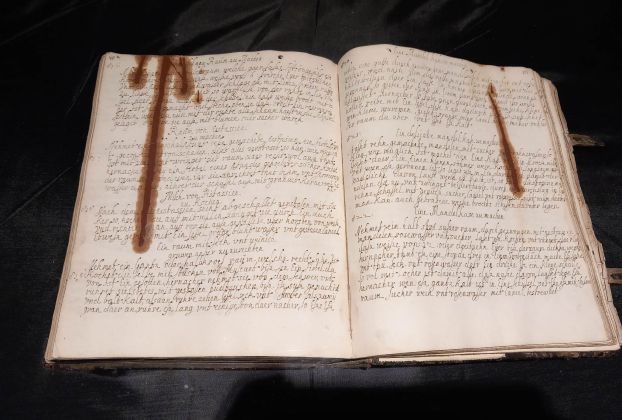This year thus far has been rather hectic, with a new website to develop, another yet private project to finish, my work, knee problems and a cat that needed surgery. It thus was really a treat that I unexpectedly could join John from Adel in Nederland to a very special evening at nearby Landgoed Nienoord in the evening of Wednesday 18 January. That the weather was quite bad with wet snow luckily didn’t cause too much problems.
Already in June I visited the estate when a Midsummer market was being held. I also had a look at the small but interesting Occa Ripperda exhibition. Since I’ve heard of this lady I have been following her Facebook site and she also has her own website nowadays, as she turns out to be a very interesting person, even with a real royal connection. This time a tasting session and a lecture was on my program.


Who is Occa Ripperda?
Occa Johanna Ripperda was born in 1619 at the noble estate of her family in Farmsum, in the province of Groningen quite near the Dutch-German border. Her parents were Hero Maurits Ripperda and Anna Margaretha Rengers. Part of her youth she spent in The Hague, where her father worked. Later she lived with her uncle and aunt at the Dekema State in Jelsum, province of Friesland. As they had functions at court in Leeuwarden, Occa was also known there.
In 1639 Occa married Enno Adam von Inn- und Knyphausen, lord of Jennelt. The couple lived at the estate in Jennelt and in Emden, both in East Frisia. Among the possessions of her husband was also the castle of Klempenow, in Swedish Western Pomerania, as her husband and his father had served in the Swedish army. Enno Adam already died in 1654. To ensure that Klempenow remained in the possession of the family she travelled to Brussels, where she had an audience with Queen Christina, who had just abdicated.
1656 Occa remarried the Swedish count Erik Stenbock, who didn’t live far from Klempenow. He only died two and a half years after his marriage during the siege of Copenhagen. He was buried in Göteborg, Sweden, a year later. Occa remained in Sweden after his death. In 1666 she had to cede the family castle of Lindholmen to her step-children.
In 1671 she was asked to become the Chief Court Mistress of the Swedish Queen Dowager Hedvig Eleonora, the highest function at court. In the years to follow she accompanied her mistress during her travels through Sweden and Schleswig-Holstein. Occa died at the royal palace in Stockholm on 23 November 1686, deeply mourned by the Queen Dowager and her four surviving children (she was the mother of six). After having been buried at the Riddarholmskyrkan in Stockholm, Occa was then transfered to Jennelt, East Frisia, to be buried next to her first husband. Her richly decorated coffin is still there.
The noble families Inn- und Knyphausen and Stenbock by the way still exist.


Why is she in the news nowadays?
Although it is hardly known what she looked like, during a search through the archives, letters of Occa to the Queen Dowager, her children and others were recovered. But something else was left: her cookbook with over 1,000 recipes. In the past centuries it travelled from Stockholm to Leer and Emden. Historian Redmer Alma is busy creating a book with the recipes varying from French, Dutch and Groninger delicacies to German and Swedish ones. She even knew something about the exotic kitchen and used spices from countries far away. It gives an exclusive look in the noble kitchen of the 17th century, about which thus far wasn’t really known a lot.
In the past year Museum Nienoord had a small exhibition about Occa (open until the end of February 2023), and they organised several activities. Also in other museums, like the Dekema State, one could hear a bit about Occa Johanna Ripperda.
The tasting session and lecture
The very interesting lecture about Occa Ripperda by Redmer Alma was preceded by a tasting session. Top chef Carolina Verhoeven had prepared several recipes from Occa’s cookbook. John and I enjoyed onion soup with rye bread and fennel, beef pie, parsnip, as well as almond cake with semolina. It all tasted surprisingly good, so honestly we are looking forward to the publication of the book, so that we maybe can try to create some 17th century recipes at home ourselves.
